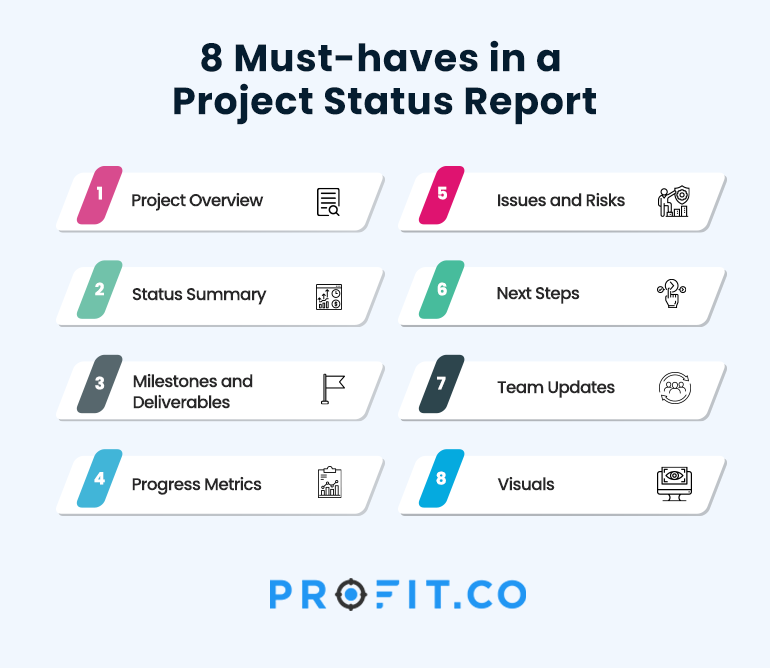Gone are the days of scrambling for updates or piecing together progress from a patchwork of emails and spreadsheets. Effective project status reports streamline communication, identify roadblocks, and make sure everyone is aligned in the same direction.
But what exactly is a project status report, and how can you craft one that empowers your team and impresses stakeholders?
This blog post explores the world of project status reports, equipping you with the knowledge and tools to transform them from a chore into a strategic advantage.
Demystifying the Project Status Report
At its core, a project status report is a concise, timely update on the progress of your project. It offers a high-level overview, allowing stakeholders and team members to understand the current state of affairs – are things on track, at risk, or off track?
Imagine a dashboard with a clear view of your project’s health. That’s the essence of a well-crafted status report. It eliminates information overload while providing the crucial details necessary for informed decision-making.
A project status report serves several critical functions
- Maintaining Project Health: Regular reports act as a temperature check, highlighting potential problems before they snowball into major issues.
- Communication: It provides a clear and concise update on the project’s progress, milestones, and deliverables.
- Accountability: It holds team members accountable for their tasks and deadlines.
- Tracking Progress: They offer a digestible snapshot of the past week or month, enabling stakeholders to stay informed on how the project aligns with the initial plan.
- Reduced Manual Work: Project management tools centralize information, allowing you to generate reports with a click.
- Transparency and Alignment: It offers visibility into project developments, potential risks, and issues. This alignment makes sure everyone is working towards the same goals.
- Decision-Making: It equips stakeholders with the information needed to make informed decisions.
- Proactive Blocker Identification: Is a task lagging behind schedule? A resource constraint putting a wrench in your plans? Status reports allow you to identify potential problems early on, enabling proactive solutions before they derail your project.
- Farewell Status Meetings: Regular reports render them obsolete.
- No Micromanagement: It’s about empowering your team and stakeholders with the knowledge they need to be successful.
“When I take a look at a company’s annual report, if I don’t understand it, they don’t want me to understand it.”
Elements of an Effective Project Status Report
To create a compelling project status report, it’s important to include the following key elements

1. Project Overview
A brief project summary, including objectives, scope, and key deliverables. This sets the context for the report.
- Title: Clearly state the project’s name and the reporting period.
- Objective: Summarize the project’s goals and objectives in one or two sentences.
- Scope: Briefly describe the project’s scope, including the major tasks and deliverables.
- Key Stakeholders: List the primary stakeholders and their roles.
2. Status Summary
A high-level snapshot of the project’s current status, often color-coded
- Green: On track with no significant issues.
- Yellow: At risk with some concerns that need attention.
- Red: Behind schedule or facing significant challenges.
3. Milestones and Deliverables
Detailed information about recent milestones achieved and upcoming deliverables, along with their deadlines.
- Name: The name of the milestone.
- Due Date: The original due date.
- Status: Whether it is completed, on track, or delayed.
- Description: A brief description of the milestone.
4.Progress Metrics
Quantitative data that shows the project’s progress, such as percentage completed, budget spent, and hours worked.
- Percentage Completed: How much of the project has been completed?
- Budget Utilization: How much of the budget has been spent compared to the planned expenditure.
- Time Tracking: Hours worked versus hours planned.
- Visual aids used like bar graphs and pie charts can make these metrics more digestible and engaging.
5. Issues and Risks
Identification of any challenges or risks encountered, along with their potential impact and mitigation strategies.
- Description: A clear and concise description of the issue or risk.
- Impact: The potential impact on the project.
- Mitigation: The steps to mitigate the risk or resolve the issue.
- Status: Whether it is open, closed, or being monitored.
6. Next Steps
An outline of the next actions and tasks planned for the upcoming reporting period.
- Task: The specific task to be completed.
- Responsible Person: Who is responsible for the task?
- Due Date: When the task is due.
- Status: The current status of the task.
7. Team Updates
Information about team performance, availability, and any changes in team composition.
- Team Member: Name of the team member.
- Role: Their role in the project.
- Availability: Any changes in their availability (e.g., vacations, sick leave).
- Performance: A brief note on their performance and any recognition for exceptional contributions.
8. Visuals
Charts, graphs, and images that visually represent the project’s progress and status.
- Gantt Charts: Ideal for showcasing project timelines and schedules.
- Progress Bars: These are useful for illustrating the completion percentage of tasks and milestones.
- Pie Charts and Bar Graphs: Great for depicting budget utilization, time tracking, and other quantitative metrics.
- Infographics: This can simplify complex data and make the report more visually appealing.
To learn more about streamlining reporting for your organization
Best Practices for Writing Engaging Project Status Reports
- Stakeholders often have limited time. Ensure your report is succinct and to the point.
- Avoid jargon and complex language. Use simple, clear terms that everyone can understand.
- Don’t sugarcoat issues or risks. Honest reporting builds trust and facilitates problem-solving.
- Consider who will be reading the report. Senior executives may need a high-level overview, while team members might require more detailed information.
- Consistency is key. Regular updates help maintain momentum and keep everyone informed.
- Encourage stakeholders to provide feedback, ask questions, or take specific actions based on the report’s contents.
Example of a Well-Structured Project Status Report
Let’s walk through an example of a project status report for a fictional project: “Website Redesign.”
Project Status Report: Website Redesign
Reporting Period: May 1 – May 31, 2024
Project Overview:
- Objective: Redesign the corporate website to improve user experience and increase conversion rates.
- Scope: The project includes a complete overhaul of the site’s design, integration with a new CMS, and implementation of enhanced SEO features.
Key Stakeholders:
- Project Sponsor: Jane Doe
- Project Manager: John Smith
- Development Team Lead: Alice Johnson
- Marketing Lead: Bob Brown
Status Summary:
Current Status: On track
The project is progressing well with no significant issues. The design phase is complete, and development is underway.
Milestones and Deliverables:
| Mile Stone | Due Date | Status | Description |
|---|---|---|---|
| Design Phase Complete | May 15,2024 | Completed | Final design mockups approved by stakeholders |
| Development Start | May 15,2024 | On Track | Development of new website commenced |
| Content Integration | June 15,2024 | Upcoming | Integration of new content into the CMS |
Progress Metrics:
- Percentage Completed: 40%
- Budget Utilization: 35% of the total budget
- Hours Worked: 320/800 planned hours
Issues and Risks:
| Issue/Risk | Impact | Mitigation | Status |
|---|---|---|---|
| Potential Delay in Content Delivery | Moderate | Coordinating with content team to expedite delivery | Open |
| CMS Integration Challenges | High | Engage with CMS experts to resolve issues | In Progress |
Next Steps:
| Task | Responsible Person | Due Date | Status |
|---|---|---|---|
| Content Development Phase | Alice Johnson | June 10, 2024 | On Track |
| Begin Content Integration | Bob Brown | June 15, 2024 | Upcoming |
| Conduct User Testing | John Smith | June 20, 2024 | Upcoming |
Team Updates:
- Alice Johnson: Available full-time, leading the development team.
- Bob Brown: Available part-time due to other marketing commitments.
- Recognition: Alice Johnson for outstanding leadership in the design phase.
Visuals:
- Gantt Chart
- Progress Bar
- Budget Utilization Pie Chart
Conclusion
Crafting an engaging project status report is an art that combines clarity, honesty, and visual appeal. By focusing on key elements, maintaining transparency, and tailoring the report to your audience, you can ensure that your reports are informative but also compelling and actionable. Remember, a well-crafted project status report is a powerful tool that keeps your project on track and your stakeholders in the loop.
By following the guidelines outlined in this blog, you’ll be well-equipped to create project status reports that drive success and foster collaboration. Happy reporting!
Ready to start your project management journey today?
Related Articles
-
How to Use Decision Tree Analysis to Make Confident Choices
Have you ever felt paralyzed by indecision? You’re not alone. Decision-making can feel overwhelming, whether you’re deciding on a career... Read more
-
How to Break Through Creative Barriers Using the Framestorming Technique for Innovation
If you've ever hit a creative roadblock, you know how frustrating it can be. The pressure to develop the perfect... Read more
-
Mastering Project Tracking: Strategies for Seamless Workflow Management
Project management requires close progress monitoring to allow swift adjustment where necessary to ensure timely success. Effective project management plays... Read more
-
5 Phases of Project Management and How to Master Them with OKRs
Managing a project can sometimes feel like walking a tightrope blindfolded. You've likely seen the daunting numbers less than half... Read more

